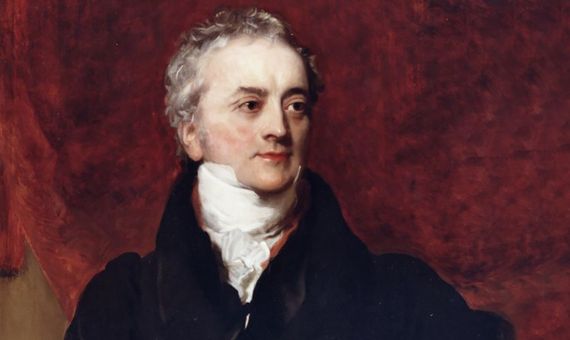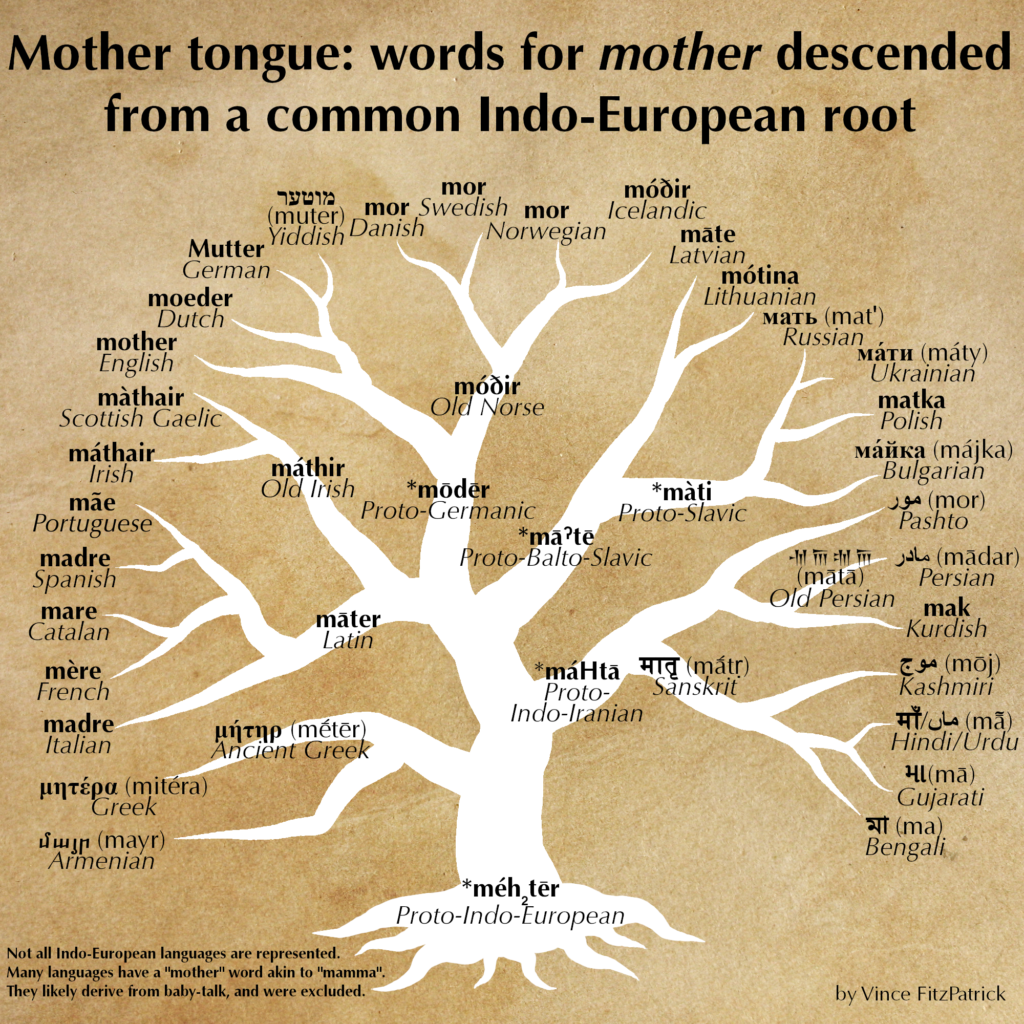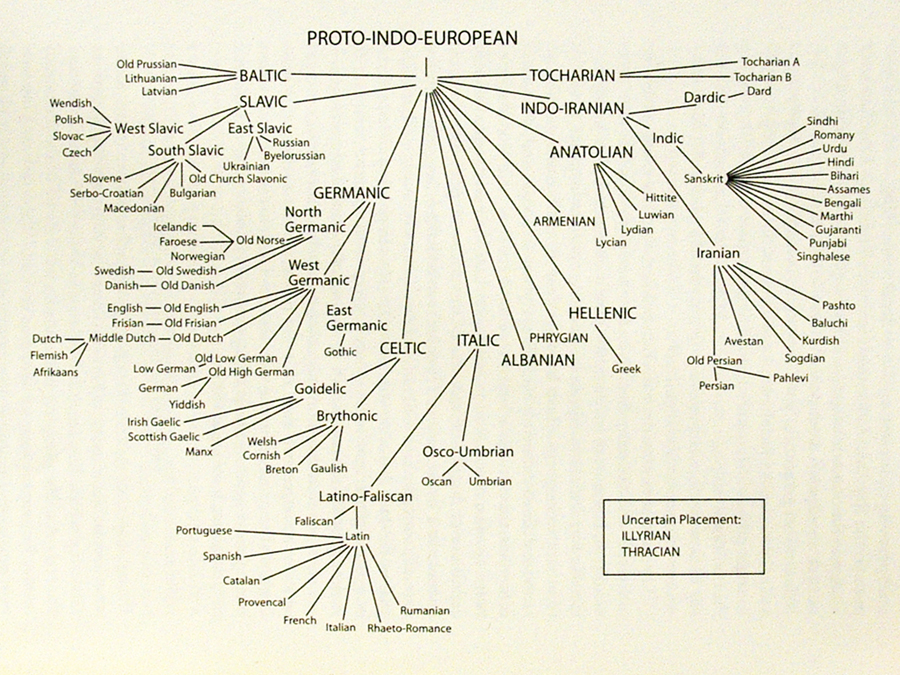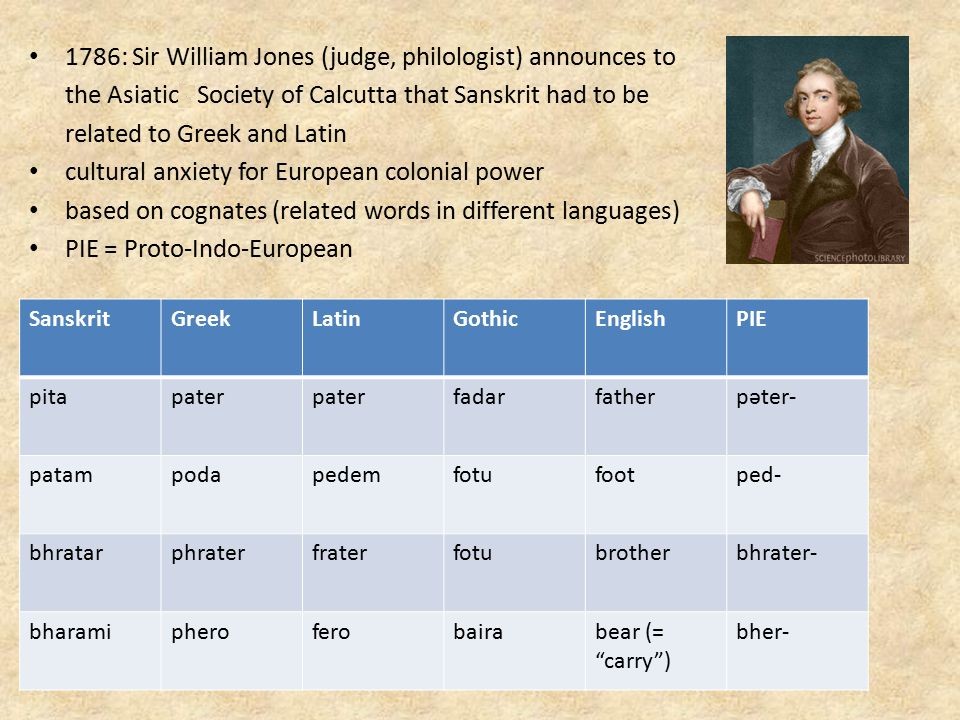The Indo-European Language Family
Various languages around the world are related to each other and speakers can feel the similarity for example Spanish and Italian. One doesn’t need to be an academic to sense or realise these languages are ‘related’ as their similarity and varying degrees of mutual intelligibility cause people to arrive at that conclusion consciously or subconsciously.
However if we ponder upon this somewhat deeper we then realise that maybe they are derivatives of an older parent language, and in the aforementioned example of Spanish and Italian that is indeed the case with their parent language being Latin, or to be more precise ‘vulgar Latin’, the vernacular form of Latin spoken by Roman soldiers (who were often not ‘Romans’ ethnically as in they did not hail from the city of Rome or the region of Latium which Rome is located in or even the Italian peninsula, but could often be Germanic or Celtic soldiers serving in the legions of Rome, thus their Latin may not have been comparable to that of a fluent native speaker from Rome in the first place!).
Anyway so languages are often related to each other and like biological human families have siblings, descendants and ancestors and the biggest and most important language family of all in the world is the Indo-European language family.
The origins of the theory.
As its name suggests there is a connection between India and Europe. The Indo-European languages were originally spoken from Ireland in the west to Bangladesh in the east. Now of course they are spoken beyond that region of western Europe and north eastern India including the whole of the Americas from Alaska to Tierra del Fuego in the southern tip of south America.
Related Articles :
1. The Germanic language family
2. The Slavic language family
3. The Latin language family

The term, “Indo-European” is first known to have been used by the brilliant British scientist, Thomas Young. Though others had preceded Young in noting various lexical similarities between Latin, Greek and Sanskrit (all of whom hold a high place in their respective cultures as either scriptural languages or languages of major importance in ancient and classical poetry and literature), it is Young who gifted us with this term which clearly indicates that this language family is spoken from Europe to India.
However Young was merely following on from the work of William Jones. Jones, a Welshman had a Celtic language as his mother tongue, but learnt English being a resident of Britain, English being a Germanic language. Went on to study classical Greek and Latin in university, a Hellenic and Italic language respectively. Then later learnt Persian and when working in India learnt Sanskrit, an Iranic and Indic language.
Through his experiences and other factors he was able to notice the commonalities existent in these languages in particularly Greek, Latin and Sanskrit and proposed the idea of a common ancestor for what appeared to be widely divergent languages spoken by peoples separated by thousands of miles and racially totally different. He presented his idea in 1786.
Similarities between the Indo-European languages.
Aside from believing in the expertise of linguists who have written about this, what examples can we personally see on the commonalities and similiarities between languages in Europe and India? Well let’s take a look at some examples.
A couple of points to note from that table above.
- The English versions do not start with a ‘Q/K’ sound but it is speculated that the ancestor of the Germanic languages (which English is a memberof) proto Indo-European may have had the ‘Q/K’ sound for question words (interrogatives) but the Germanic languages slowly changed their pronunciation to omit it.
- The “por” in the Spanish “por que” (why) and the “per” in the Italian “perche” is actually a preposition attached to the word ‘que’, in other words it’s like saying “for what” in English.
However, this is just one sample and the lexical similarities between different European languages are much deeper and extensive than that.
Let us look at the word mother.

This linguistic similarity does not necessarily imply a racial similarity. Language and ethnicity are two different things. People in Jamaica speak English but are of largely African stock and not Germano-Celtic like the English.
So where did proto-Indo-European come from?
No one can say for certain but some linguists have attempted to use various bits of evidence and data (e.g. words to do with the environment which are common to all Indo-European languages) and said it would have been north of the Caspian sea, though some say it may have been in a location which is in what is now modern Ukraine. The technical name for this homeland is ‘Urheimat’, a term used in linguistics to denote where a language was originally spoken.
Here is a diagram showing the Indo-European language family.

Another diagram:
Proto-Indo-European (PIE)
│
├── Anatolian †
│ ├─ Hittite †
│ ├─ Luwian †
│ ├─ Lycian †
│ └─ Lydian †
│
├── Tocharian †
│ ├─ Tocharian A (Agnean/Turfanian) †
│ └─ Tocharian B (Kuchean) †
│
├── Indo-Iranian
│ │
│ ├── Indic (Indo-Aryan)
│ │ ├─ Vedic Sanskrit †
│ │ ├─ Classical Sanskrit
│ │ ├─ Hindi / Urdu
│ │ ├─ Bengali
│ │ ├─ Punjabi
│ │ ├─ Marathi
│ │ ├─ Gujarati
│ │ ├─ Sinhala
│ │ └─ Nepali
│ │
│ └── Iranian
│ ├─ Old Persian †
│ ├─ Avestan †
│ ├─ Persian (Farsi)
│ ├─ Kurdish
│ ├─ Pashto
│ ├─ Balochi
│ └─ Tajik
│
├── Greek (Hellenic)
│ ├─ Ancient Greek †
│ └─ Modern Greek
│
├── Armenian
│ └─ Armenian
│
├── Albanian
│ └─ Albanian
│
├── Italic
│ │
│ ├─ Latin †
│ └── Romance Languages
│ ├─ Italian
│ ├─ French
│ ├─ Spanish
│ ├─ Portuguese
│ ├─ Romanian
│ └─ Catalan / Occitan
│
├── Celtic
│ │
│ ├── Continental Celtic †
│ │ ├─ Gaulish †
│ │ └─ Celtiberian †
│ │
│ └── Insular Celtic
│ ├─ Goidelic (Gaelic)
│ │ ├─ Irish
│ │ ├─ Scottish Gaelic
│ │ └─ Manx
│ │
│ └─ Brittonic
│ ├─ Welsh
│ ├─ Breton
│ └─ Cornish
│
├── Germanic
│ │
│ ├── West Germanic
│ │ ├─ English
│ │ ├─ German
│ │ ├─ Dutch
│ │ ├─ Afrikaans
│ │ └─ Frisian
│ │
│ ├── North Germanic (Scandinavian)
│ │ ├─ Danish
│ │ ├─ Swedish
│ │ ├─ Norwegian
│ │ ├─ Icelandic
│ │ └─ Faroese
│ │
│ └── East Germanic †
│ └─ Gothic †
│
├── Balto-Slavic
│ │
│ ├── Baltic
│ │ ├─ Lithuanian
│ │ └─ Latvian
│ │
│ └── Slavic
│ ├─ East Slavic
│ │ ├─ Russian
│ │ ├─ Ukrainian
│ │ └─ Belarusian
│ │
│ ├─ West Slavic
│ │ ├─ Polish
│ │ ├─ Czech
│ │ └─ Slovak
│ │
│ └─ South Slavic
│ ├─ Bulgarian
│ ├─ Macedonian
│ ├─ Serbian / Croatian / Bosnian / Montenegrin
│ ├─ Slovene
│ └─ Church Slavonic †
│
└── (Hypothesised) Other Extinct Branches
└─ Illyrian † (poorly attested)
The impact and extent of the Indo-European language family.
It’s impact is immense.
- Its the biggest language family in the world by far, with at least 40% of all humanity speaking a Indo-European language.
- It includes the most important and influential language in the world, English. The language of international business, travel, science and the world’s most popular films and songs.
- It includes Sanskrit, the language of India’s religious texts.
- Latin the language of the Roman Empire which spanned from the borders of Persia in the east to Britain in the west and Germany in the north to Libya in the south is an Indo-European tongue. Latin also became the language of religion and learning in medieval Europe.
- Spanish the main language of south America is Indo-European.
We could continue but that suffices to give a brief idea of how influential this language family, whose original form may have been spoken by tribsemen north of the Caspian and Black seas, has become.
To have an idea what Proto-Indo-European may have sounded like you can watch this video.
Here is another video talking about the history and nature of the Indo-European language family.
Thank you for reading.
Tell us what you think in the comments section below!
- Afrikaans, click on this link.
- Albanian, click on this link.
- Amharic, click on this link.
- Arabic, click on this link
- Armenian, click on this link.
- Assamese, click on this link.
- Aymara, click on this link.
- Azeri,click on this link.
- Bambara, click on this link.
- Basque, click on this link.
- Belarusian, click on this link.
- Bengali, click on this link.
- Bosnian, click on this link.
- Bulgarian, click on this link.
- Catalan, click on this link.
- Cebuano, click on this link.
- Chewa, click on this link.
- Chinese, click on this link.
- Corsican, click on this link.
- Croatian, click on this link.
- Czech, click on this link.
- Danish, click on this link.
- Dhivehi, click on this link.
- Dogri, click on this link.
- Dutch, click on this link.
- Estonian, click on this link.
- Ewe, click on this link.
- Faroese, click on this link.
- Fijian, click on this link.
- Filipino, click on this link.
- Finnish, click on this link.
- Fon, click on this link.
- French, click on this link.
- Frisian, click on this link.
- Fulani, click on this link.
- Ga, click on this link.
- Galician, click on this link.
- Georgian, click on this link.
- German, click on this link.
- Greek, click on this link.
- Guarani, click on this link.
- Hausa, click on this link.
- Hawaiian, click on this link.
- Hindi, click on this link.
- Hunsrick, click on this link.
- Hungarian, click on this link.
- Icelandic, click on this link.
- Igbo, click on this link.
- Ilocano, click on this link.
- Indonesian, click on this link.
- Inuktut, click on this link.
- Spanish, click on this link.




